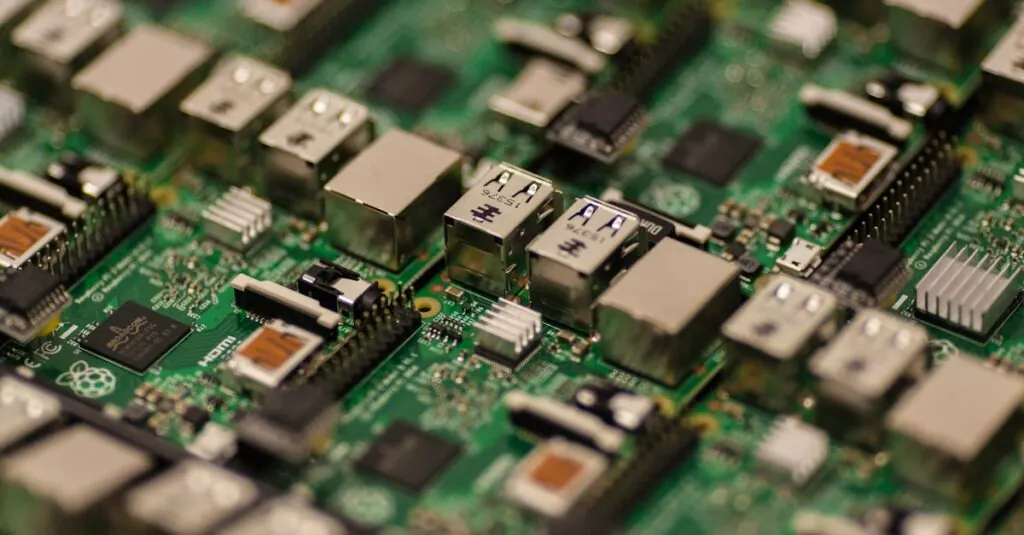Table of Contents
ToggleIn a world where Wi-Fi signals are stronger than most relationships, it’s easy to lose track of digital wellbeing. Scrolling through social media can feel like a never-ending rabbit hole, with each click pulling you deeper into a vortex of memes and cat videos. But what if he told you that achieving balance in your online life isn’t just possible—it’s essential?
As the digital landscape continues to expand, the need for a healthy relationship with technology has never been more critical. Finding that sweet spot between connectivity and sanity can help improve focus, reduce stress, and even boost overall happiness. So grab your device, kick back, and discover how to navigate the Wi-Fi jungle while keeping your digital wellbeing in check. After all, who said you can’t have fun while being mindful?
Understanding Digital Wellbeing
Digital wellbeing refers to the state of a person’s physical and mental health in relation to their technology use. This concept encompasses the balance between leveraging technology and maintaining personal well-being, focusing on positive online experiences.
Definition of Digital Wellbeing
Digital wellbeing is about ensuring that technology enhances life, rather than detracting from it. It incorporates mindfulness in tech use, emphasizing purposeful engagement. Consider how social media impacts mood; excessive scrolling often leads to stress. Individuals must foster healthy habits that promote constructive interaction with digital platforms. The objective is to create a supportive environment where technology contributes positively to one’s life.
Importance of Digital Wellbeing
Maintaining digital wellbeing is vital for overall health and productivity. Excessive screen time contributes to mental fatigue and decreases concentration. Studies show that balanced technology use can enhance focus and reduce stress. Adopting healthy digital habits supports emotional well-being and better social connections. Individuals effectively manage their online experiences cultivate resilience against distractions. Mindful technology use strengthens relationships both online and offline, providing more fulfilling interactions.
The Role of Wi-Fi in Digital Wellbeing
Wi-Fi plays a crucial role in shaping digital wellbeing. It enhances connectivity and accessibility, enabling individuals to interact with information and communities more efficiently.
Connectivity and Accessibility
Access to Wi-Fi networks ensures seamless connectivity to digital platforms. Fast internet connections facilitate educational and professional opportunities. They also promote access to mental health resources and support networks. Individuals can maintain social ties through video calls and instant messaging apps, fostering a sense of community. A reliable connection allows users to manage their technology use effectively, choosing when to engage and when to disconnect.
Influence on Daily Life
Wi-Fi influences daily routines and activities significantly. Most people rely on it for work, learning, and socialization. This reliance can lead to challenges if the connection becomes overwhelming. Notifications from social media can distract users, pulling attention away from important tasks. Conversely, mindful connectivity enables users to enjoy the benefits of digital interactions without succumbing to stress. Regular breaks from connectivity can improve mental clarity and boost overall wellbeing. Balancing online time with offline activities yields a healthier digital experience.
Benefits of Promoting Digital Wellbeing on Wi-Fi
Promoting digital wellbeing using Wi-Fi brings numerous advantages. It enhances both focus and mental health significantly.
Enhanced Focus and Productivity
Improved concentration stems from balanced Wi-Fi use. Individuals can engage more purposefully with tasks without distractions. Mindful usage minimizes interruptions from notifications, allowing deeper focus on work. Studies show that structured online breaks increase overall productivity. Efficient time management encourages task completion and reduces stress. Setting specific online intervals contributes to a healthier work-life balance.
Improved Mental Health
Enhancing mental health becomes easier through mindful Wi-Fi practices. Purposeful connection fosters social engagements that strengthen relationships. Taking regular breaks from online activities supports mental clarity, reducing feelings of anxiety and overwhelm. Research indicates that intentional use of digital tools leads to a more fulfilling online experience. Individuals experience improved emotional wellbeing when they manage their online presence effectively. Promoting community and support through digital platforms further contributes to overall happiness.
Challenges to Digital Wellbeing on Wi-Fi
Maintaining digital wellbeing on Wi-Fi presents several significant challenges.
Addiction to Connectivity
Addiction to connectivity emerges as a prominent issue. Individuals frequently check their devices for updates, leading to compulsive behavior. This constant need for connection can disrupt daily life, affecting focus and relationships. Research highlights that excessive internet use correlates with mental health problems, such as anxiety and depression. Establishing technology-free time can help mitigate this challenge, promoting healthier habits and fostering real-world interactions. Intentional disconnection during personal time provides space for reflection and rejuvenation, encouraging balance between digital and offline experiences.
Digital Distractions
Digital distractions create barriers to maintaining focus. Notifications and social media alerts often disrupt important tasks, pulling attention away from critical responsibilities. Studies illustrate that the average person checks their phone over 100 times daily, significantly impairing concentration. Eliminating unnecessary notifications can enhance productivity by allowing individuals to engage deeply with their tasks. Additionally, setting specific time blocks for online activities reduces the urge to multitask, optimizing focus. Prioritizing distractions by minimizing screen time not only improves efficiency, but also enriches overall digital wellbeing.
Strategies for Enhancing Digital Wellbeing on Wi-Fi
Enhancing digital wellbeing on Wi-Fi involves implementing effective strategies that promote focused and balanced technology use. Setting clear limits encourages healthier online habits.
Setting Boundaries
Establishing specific timeframes for online activities enhances mindfulness around technology use. Designating tech-free times prevents excessive screen time and supports mental clarity. Choosing certain environments for Wi-Fi activities, such as workspaces or relaxation areas, fosters a healthy separation between work and personal life. Reducing screen exposure, especially before bedtime, improves sleep quality by minimizing disruptions from devices. Communicating boundaries with friends and family leads to a supportive environment that encourages intentional technology engagement.
Utilizing Apps and Tools
Utilizing apps designed for digital wellbeing can significantly enhance focus. Apps that track screen time help individuals stay aware of their usage patterns. Implementing tools that block distracting websites during work hours promotes uninterrupted productivity. Mindfulness applications cultivate healthier tech habits by encouraging users to pause and reflect on their online interactions. Notifications can be managed through settings that prioritize important alerts, reducing unnecessary distractions. Integrating these tools creates a more intentional approach to Wi-Fi usage, ultimately supporting emotional wellbeing.
Conclusion
Embracing digital wellbeing on Wi-Fi is crucial for navigating today’s tech-driven world. By prioritizing mindful connectivity individuals can enhance their focus and emotional health. Setting boundaries and taking regular breaks from online activities not only reduces distractions but also fosters deeper connections with others.
Incorporating tools and strategies designed for digital wellbeing can lead to more intentional technology use. This balanced approach encourages a healthier relationship with technology while promoting overall happiness. As individuals cultivate these habits they pave the way for a more fulfilling digital experience that supports both personal and professional growth.




